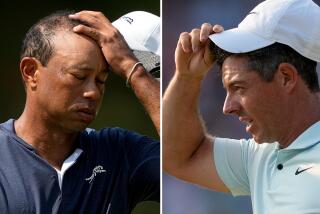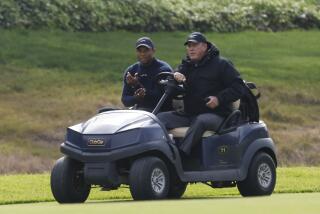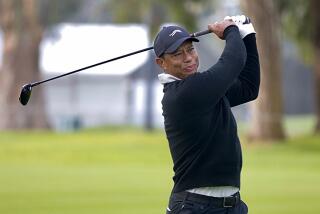Show stopper?
Tiger Woods wasn’t the only one grimacing as pain radiated from his surgically repaired left knee.
Golf’s brightest star won’t turn 33 until later this year, but his gritty, play-through-the-pain victory over Rocco Mediate in sudden death Monday at the U.S. Open in La Jolla served preliminary notice to the golf industry that not even Tiger can stay in the hunt forever.
Woods had been trimming back his tournament obligations even before the knee required surgery this spring. He played 26 tournaments worldwide in 2005, 21 in 2006 and 17 last year. And, in each of the last two years, Woods played his fewest PGA Tour events -- 15 -- since turning pro.
Woods on Monday sparked intense speculation about whether his knee will demand further medical care and, perhaps, force another leave of absence.
“He’ll be around for a long, long time,” predicted Charlie Kammerer, publisher of Golf Magazine and golf.com. “But he’s clearly going to focus on his commitments to the Buick, the majors, his own tournament, and then he’ll cherry-pick a few more tournaments.”
Should Woods throttle back even further for personal or medical reasons, the golf industry will have to “learn how to better take advantage of Tiger when you know he’s going to be playing,” Kammerer said. It could be a steep learning curve because, by almost any measure, the Tiger Effect is real.
Consider off-the-course records broken during the 2008 U.S. Open:
* NBC recorded its best Monday golf broadcast rating in 30 years, and ESPN described its slice of the action as the most-viewed golf telecast in cable TV history.
* PGA.com, PGATour.com, NBCSports.com and Sports Illustrated’s golf.com were among the websites that set records on Monday as fans stuck at work scrambled to stay abreast of the 18-hole playoff and the sudden-death win.
* An estimated 24,000 fans, double the number during the last Open playoff seven years ago, lined Torrey Pines’ fairways.
* CNBC reported, with tongue partly in cheek, that New York Stock Exchange trading slipped by 9.2% while Woods and Mediate slugged it out.
Golf won’t be the first sport to deal with the prospect of a dimming star.
“As hard as it is for some of us to remember, Tiger Woods hasn’t been playing golf forever,” said Neal Pilson, a sports media consultant and former CBS Sports executive. “It was true for Michael Jordan and the NBA, and Muhammad Ali in boxing.
“Golf will survive and do very well without Tiger Woods,” Pilson said. “But at some point people have to understand that Tiger isn’t going to play forever. It’s a natural phenomenon and we’re all aware of it -- advertisers, sponsors, golf tournament directors and other golfers.”
Woods remains the sports marketing world’s dominant player. He has been the top-earning American athlete on Sports Illustrated’s Fortunate 40 list for the last five years -- registering $128 million this past year alone from salary, winnings, endorsements and appearance fees.
Yet sports marketers agree that last weekend’s golf love fest wasn’t simply about Tiger. Woods’ first tournament action since knee surgery drew fans in, but it was the compelling story line that kept them hooked.
“You couldn’t have written it much better than what actually happened” as Mediate kept battling back, said Phil Sharpe, senior vice president of technology and operations for Turner Broadcasting, which operates the PGA.com and PGATour.com websites.
“Tiger always drives big traffic spikes on our webs,” Kammerer said. “But Rocco was just so emotional and so happy to be there that he was also a great story. He’s 45 years old, had to qualify to get in and he had such great fight.”
Woods remains the single biggest driver when it comes to golf-related television ratings and web traffic. NBC, for example, gets “more than a 50% jump when he plays, and an even more pronounced jump when he’s among the leaders,” network spokesman Brian Walker said.
Crunch the numbers a bit more, said Steve Dennis, the PGA Tour’s senior director of communications and strategy, and the Tiger Effect isn’t as powerful as some might believe.
“It’s a confluence of things,” Dennis said. “It’s Tiger, to be sure, but it’s also a great supporting cast and a great story on the course.”
Dennis based his analysis on a recent study of Sunday afternoon network ratings for golf. Woods is increasingly likely to tee off in major tournaments that also draw most of the golf world’s better players, Dennis said, and less likely to play in lesser-known contests.
When Woods plays the bigger tournaments and finishes in the top five, Dennis said, Sunday afternoon network ratings average 4.3. But when Woods is absent -- or dramatically off his game -- the average rating falls by 26% to 3.4, which Dennis said, is still respectable.
--
More to Read
Go beyond the scoreboard
Get the latest on L.A.'s teams in the daily Sports Report newsletter.
You may occasionally receive promotional content from the Los Angeles Times.










